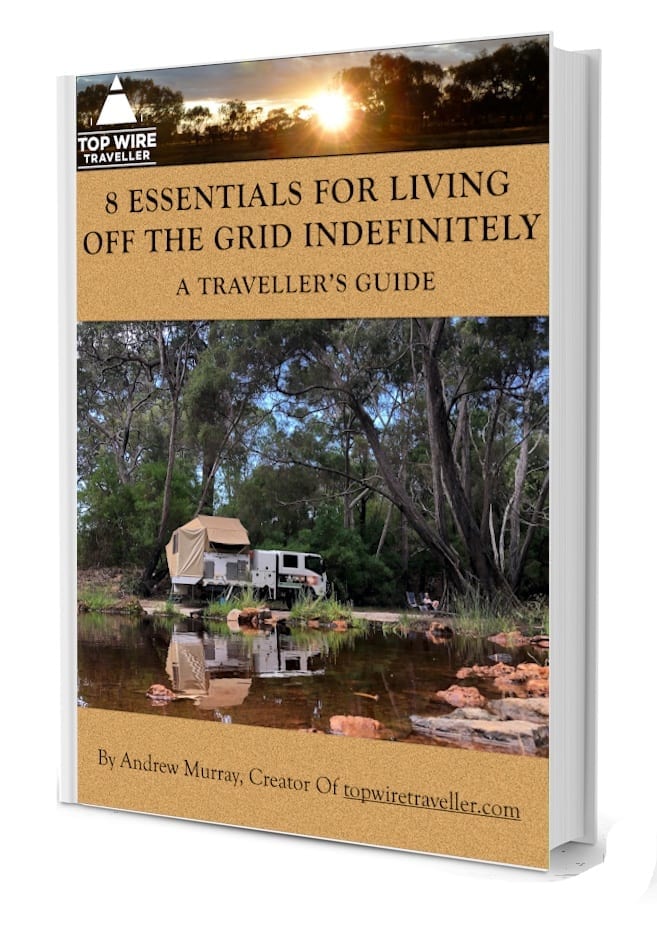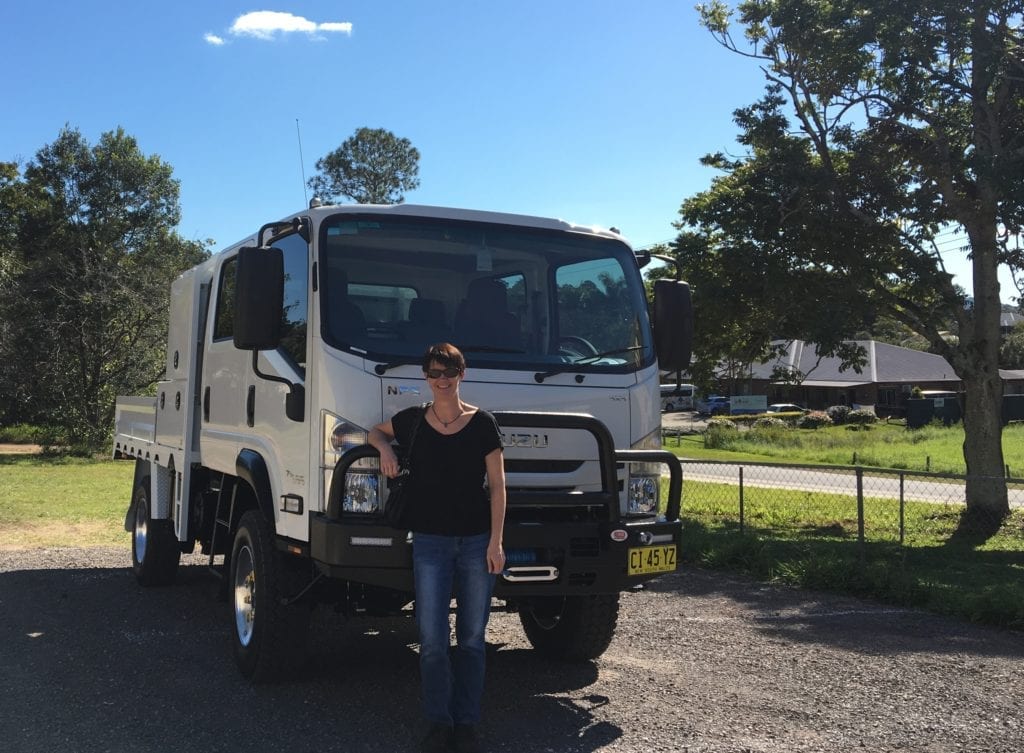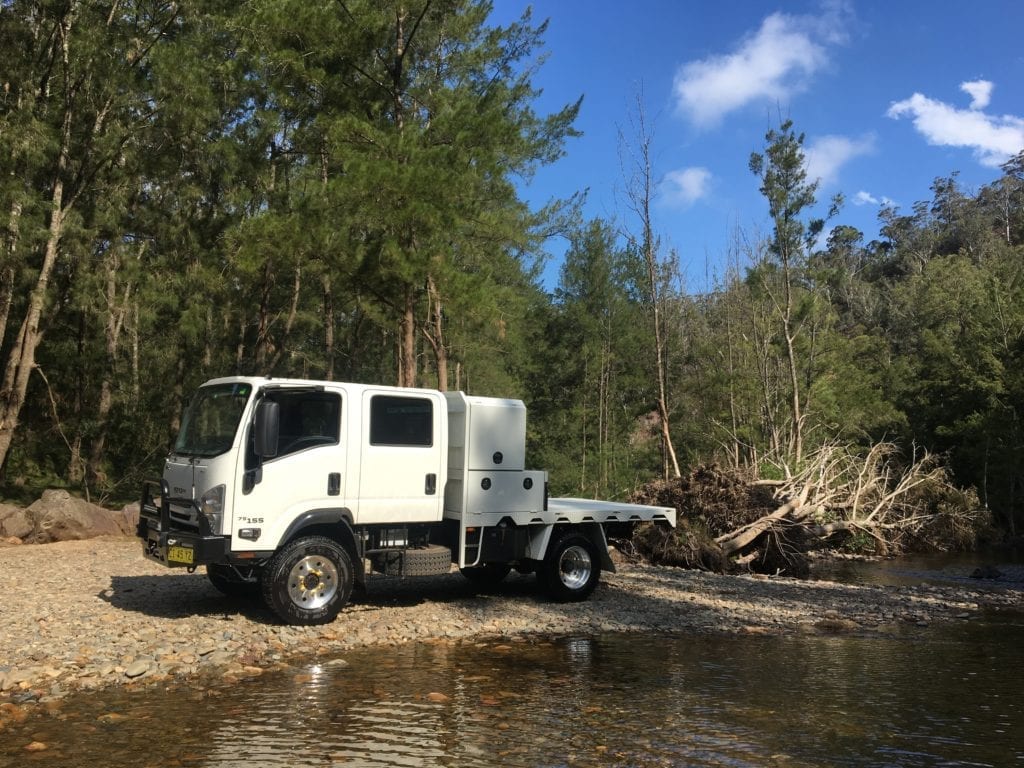… And Why An Isuzu Truck Just Might Suit You

The 8 Things You Need to Live Off-Grid
Make sure your new camper or van has these 8 essentials…
It’s Time To Travel… Indefinitely
Imagine you’ve made the decision to travel around Australia. Not just for a few weeks or even a couple of months, but indefinitely.
You’ve decided it’s time to see the real Australia – the Kimberleys, Cape York, Western Australia’s goldfields, Central Australia. You’ll have some big decisions to make. Near the top of the list is what vehicle to buy… and what you’re going to sleep in.
My wife Peta and I made this decision a few years ago… leave our current life at the end of 2017 and travel around Australia indefinitely.
Get Your Setup Right The First Time
Now Australia is a big place and has some seriously rough roads. So we needed something tough and reliable. Something to take us into truly remote areas, for extended periods of time.
We took our time choosing a setup to suit our needs. After all, it’s a big decision – one you really want to get right.

Let’s go through the process of how we chose our setup. You can then use this template to do the same. Hopefully it’ll save you lots of time, anguish and arguments!
Keep An Open Mind
It’s easy to be overwhelmed at this early stage. There are so many vehicle and camping options to choose from… so many quality products… and so much marketing hype from manufacturers.
The first thing you must do is park your biases and emotions. Sit them over in the corner of the room for now. They’ll cloud your judgment.
Big companies devote hundreds of millions of dollars every year to building a loyal following. Every one of us is susceptible to it – what’s you favourite car? Your favourite brand of jeans? Your favourite beer, wine or spirit? Why are they your favourites? Well, good marketing targets a particular audience then plays with our emotions – without us even realising it’s happening.
If you start with a bias towards a particular brand, you probably won’t end up with the best solution for your needs. Try not to fall into the “I’ve always had Brand X, I’ll never have anything else” trap. You’ll be blind to other – possibly better – possibilities.
Let’s Get Started
Start with a blank sheet of paper or spreadsheet. Write down what you believe would make a “perfect” setup for travelling indefinitely.
To get you started, this is what we wrote:
The Complete Setup
- A vehicle that can go anywhere – on road and off.
- No towing. It’s too restrictive.
- A camper with canvas. (We both love sleeping under canvas).
- Camper must be easily removable and free-standing. (We wanted to use our vehicle independently of the camper. Our plan was to set up the camper in one spot and still use the vehicle to explore the surrounding area).
- Space in the cab for all the extra bits and pieces – maps, jackets, drinks, food.
- Storage space for indefinite travel – summer & winter clothing, spare bedding, bikes, folding kayak, extra water, extra fuel, small washing machine, spare parts for vehicle, tools, second battery system, air compressor, portable water pump.
Then we listed some specifics about the vehicle:
The Vehicle
- Long-lasting and proven durability. This is critical, non-negotiable.
- Spare parts are readily available.
- Easy to maintain.
- Simple design – especially electrics and electronics.
- Tough drivetrain with no known faults or weaknesses.
- Must have a tray back, since we’d settled on a slide-on camper.
- Must be rated to carry what we need.
Camper selection is best left for another article. Suffice to say, we knew a quality slide-on camper would be heavy. So we allowed 800kg for a fully kitted out camper.
Where Does This Leave Us?
Well, three things stand out.
- Firstly, we need a tray. So we need a ute.
- Secondly, we need space. Space for all our things. Of course we always minimise what we pack, but indefinite travel requires more gear. And we wanted the ability to go for a bike ride or enjoy a paddle in a kayak. Simple as that.
- Thirdly, we would be quite heavy. This instantly rules out a whole swathe of vehicles.
What Are Our Choices?
Let’s first eliminate some candidates. Clear away the vehicles you know you’ll never be comfortable with.
I said earlier to park your biases. But keep in mind, your choices, opinions and experiences of vehicles will be unique. Let me explain.
I immediately eliminated any European vehicles. Why? In my past experiences with European vehicles, they suffer from electrical issues. I know it’s a generalisation, but it’s based on my previous experiences:
- The German car my mate had years ago… it was an electrical nightmare.
- My brother’s Swedish car that spent more of its life at an auto electrician than on the road.
- My German company car (yes one of the two prestige brands) which failed to progress on numerous occasions and had two A4 pages worth of intermittent electrical faults. Faults which were never fixed.
Then I eliminated Chinese and Indian vehicles. For me personally, they simply don’t have the runs on the board yet.
Next to go were all the 4×4 utes with 2mm thick chassis rails. I think we’ve all seen photos of utes bent in half. They’re simply not made to carry big weights day after day, especially on rough roads. Or maybe they are. Regardless, I didn’t feel comfortable taking the risk. This eliminates nearly all of them.
So what are we left with? Isuzu D-Max and Land Cruiser 79 Series. Both would need a GVM upgrade. Neither ticks the “space” box for us either. We could get around this with a chassis stretch, or even a 6-wheel conversion.
Time For Some Lateral Thinking
Okay, let’s think outside the box. What other options do we have? Well, how about a 4×4 truck? There are really only a few options:
- Isuzu NPS 4×4 rated to 7.5T GVM or de-rated to 4.5T GVM.
- Fuso Canter FG 4×4 rated to 6.5T GVM or de-rated to 4.5T GVM.
- Iveco Daily 4×4 rated to 5.5T GVM or de-rated to 4.5T GVM.
Note: Since we made our selection, the Hino 300 4×4 truck appeared on the Australian market. From all accounts, this seems like a possible option. It has a 6 speed gearbox, disc brakes all around and class-leading safety features.
Can we eliminate any of these? I did. The Iveco was gone pretty quickly. A history of repeated failures of the transfer case – strike 1. It’s European – strike 2.
Next to go was the Fuso Canter. Why? A few reasons:
- The motor seems underdone to me. A 3L engine in a truck raised potential longevity issues to me.
- Compared to the Isuzu, engine ratings were pretty asthmatic.
- Many hours of reading online forums ensued. Once the “I’m the expert, listen to me or else” forums were culled, a common theme emerged. Isuzu were at the top of the light truck tree and Fuso were just below. Owners, operators, mechanics and mine workers had a similar opinion.
- I spoke to people who owned both. The result? Same – Isuzu #1, Fuso a close second.
Don’t get me wrong. Fuso Canters have a great reputation. However an Isuzu is hard to beat. There’s a reason Isuzu has been light truck market leader in Australia since 1989.
Time To Re-Cap
So we were left with 3 candidates:
- Toyota Land Cruiser.
- Isuzu D-Max.
- Isuzu NPS.
Time to make a decision. Let’s weed them out. Remember, we’re judging them against my original criteria list. Yours will likely be quite different.
Toyota Land Cruiser 79 Series
Pros
- Solidly built, reputation for toughness.
- Truck-like chassis.
- Reliable.
- Unstoppable off road.
- Extensive dealer network Australia-wide.
- Favoured by farmers, mining companies & emergency services – sometimes in extreme conditions.
Cons
- Expensive, not great value for money.
- Very basic. Even air conditioning is still an (expensive) option.
- The rear wheel track is narrower than the front.
- Rough ride.
- Old design.
- Parts are expensive.
- Would need a GVM upgrade.
- Single cab – lack of space.
- Dual cab – would need a chassis extension.
Isuzu D-Max
Pros
- Solidly built, reputation for toughness.
- Sturdy chassis.
- Reliable.
- Excellent off road.
- Extensive dealer network Australia-wide.
- Parts are reasonably priced.
- Value for money.
- Car-like ride and interior.
Cons
- Longevity unknown.
- Would need a GVM upgrade.
- Single cab – lack of space.
- Extra cab – space still marginal.
- Dual cab – would need a chassis extension.
Isuzu NPS
Pros
- Solidly built, reputation for toughness.
- Sturdy truck chassis.
- Reliable.
- Unstoppable off road.
- Extensive dealer network Australia-wide.
- Parts are reasonably priced.
- Value for money.
- Single cab – space is marginal, but easily overcome by adding storage boxes on the tray.
- Dual cab – huge amount of space inside.
- 7.5T GVM – heaps of capacity to carry all our extras.
- Used by mining companies & emergency services – often in extreme conditions.
- Panoramic view from a tall cab.
Cons
- Fairly basic interior.
- Standard seats are uncomfortable.
- Rough ride.
- Slow, drives like a truck (funny that!).
- Need a Light Rigid licence.
- Cab height is significantly taller than the other contenders.
After this appraisal, we knocked out the D-Max. Why? Simply because the Land Cruiser and NPS both have excellent reputations. They are tough, reliable workhorses and just keep going, no matter what’s thrown at them. While the D-Max is a great vehicle, it struggles against competition of this calibre.
So Why Did We Choose An Isuzu NPS?
Several reasons:
- They are built like a truck – because they are a truck.
- Longevity has been proven time and again in extreme conditions.
- Value for money.
- No GVM upgrade or chassis stretch needed.
- By the time we had the NPS modified to suit our needs, final price was lineball with a similarly customised Land Cruiser.
- Space internally, space on the tray and space under the tray for extra fuel tanks, water tanks, spare tyres and so on.
- Engine is a large 5.2L 4 cylinder, massively detuned for longevity.
- Drivetrain is similarly over-rated, eg rear axle has a 6T rating.
In Conclusion
So the Isuzu NPS was a standout for us. You will likely reach a different conclusion, based on your requirements. And that’s fine.
Just do yourself a favour and go through the selection process carefully. It’s a big outlay and you need to be happy with the final outcome.

Go here for more How-To Guides and tips.

Get your Traveller’s Guides
… and a whole lot more at our FREE RESOURCES Page!
Any questions or comments? Go to the Comments below or join us on Pinterest, Facebook or YouTube.
Any errors or omissions are mine alone.


Hi can you tell us what folding bikes you chose. We need light and very compact. And preferably not over $1500!
Hi Meryl,
We bought a second-hand Birdy folding bike. But it was expensive!
We now use 2 mountain bikes. The folding bike wasn’t really suited… we spent more time fixing punctures than riding it! And it wasn’t really very small when folded up.
I suppose it depends on where you want to use it and how much space you have to carry it.
Cheers, Andrew
I went through the same process for towing a heavy van and also ended up with an Isuzu NPS Crewcab. I also included the US light trucks (RAM 3500, F350 etc) in my shortlist but knocked these out because they are so expensive and I was nervous about mechanical and parts support.
Once I’m too old to climb into the cab of the truck then a DMAX crewcab with a 6×4 conversion will probably be its replacement unless someone releases a decent tow vehicle.
Hi Brad,
I agree 100% regarding the US light trucks. And I’m thinking the same as you when it’s finally time to part ways with the NPS… a D-Max with a 6×4 conversion.
Cheers, Andrew
“Camper selection is best left for another article.”
… can u pls link us to it?
Hi Brad. Great question and you’ve caught me out! I somehow never completed this article, but I’m glad you reminded me. I’ll get back onto it and post a link here when it’s done.
In the meantime, here’s a link to a review of our Wedgetail Camper. It’s not about camper selection as such, but it does touch on things to look out for… quality build, quality canvas, and so on.
Hope this helps in the meantime.
Cheers, Andrew